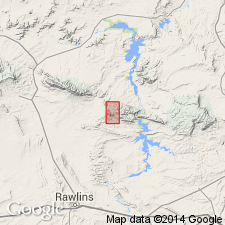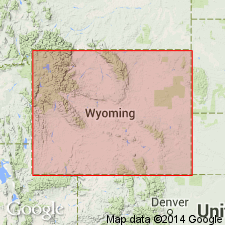
- Usage in publication:
-
- Seminoe formation*
- Modifications:
-
- Named
- Dominant lithology:
-
- Quartzite
- AAPG geologic province:
-
- Northern Rocky Mountain region
Summary:
Named presumably for Seminoe Mountains, Carbon Co, WY in the Northern Rocky Mountain region. Source of geographic name and type locality not given. Unconformably overlies unnamed andesitic greenstones and dark-green hornblende schists. Seminoe is infolded with them in highly contorted layers. Consists of banded jaspery iron-bearing quartzite. Ranges in thickness from a few ft to slightly more than 300 ft. Where well developed, Seminoe shows changes in composition from strongly ferruginous jasper at base through siliceous in middle to a layer rich in hypersthene at top. Section measured on east bank Deweese Creek, SW1/4 sec 19, T26N, R85W, is 275 ft of gray, jaspery quartzite thickly banded with black magnetite separated 125 ft above base by a 25 ft thick dark-green amphibolite schist and quartz-chlorite schist unit. Gray color attributed to presence of finely disseminated magnetite grains. Is resistant to erosion; forms knobs and ridges. Thought to be of sedimentary origin. The extremely fine grained silica and interlayered fine-grained iron oxide may indicate formation is a metamorphosed hot-spring deposit. Of pre-Cambrian age.
Source: GNU records (USGS DDS-6; Denver GNULEX).

- Usage in publication:
-
- Seminoe Formation*
- Modifications:
-
- Age modified
- AAPG geologic province:
-
- Northern Rocky Mountain region
Summary:
Age modified from Precambrian to Late Archean on basis of an age obtained from a quartz-phyric rhyodacite flow of 2.7 Ga (U-Pb zircon method) that is intercalated with metasedimentary rocks older than Seminoe. Is a banded iron-formation as much as 120 m thick found at the north end of the Seminoe Mountains, Carbon Co, WY in the Northern Rocky Mountain region.
Source: GNU records (USGS DDS-6; Denver GNULEX).
For more information, please contact Nancy Stamm, Geologic Names Committee Secretary.
Asterisk (*) indicates published by U.S. Geological Survey authors.
"No current usage" (†) implies that a name has been abandoned or has fallen into disuse. Former usage and, if known, replacement name given in parentheses ( ).
Slash (/) indicates name conflicts with nomenclatural guidelines (CSN, 1933; ACSN, 1961, 1970; NACSN, 1983, 2005, 2021). May be explained within brackets ([ ]).

